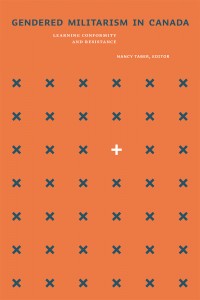Canada in the First World War with a population of 8 million lost 61,000 dead. The tiny Kingdom of Serbia, half our size, lost 1.1 million. By any measure of modesty or good sense Canadians have some nerve in boasting of our wartime exploits as a defining moment in history. Yet the sheen of reflected military glory even today is irresistible to certain politicians who promote a “national identity that is masculinist and militarized”, writes Prof. Nancy Taber of Brock University.
Gendered Militarism in Canada examines the contradiction. It is a thoughtful book. Editor Taber brings street cred to the topic; she is a former Sea King navigator.
“I quite enjoyed serving in the military and was proud to do so,” Taber writes. “Gradually however, I began to question first my place in the military and then the military’s place in society. This question stemmed from my experience as a woman in a male-dominated institution. Always having to be on my toes, knowing I was somehow different, was an undercurrent throughout my service despite my overall success. Near the end of my short service contract (four years of university plus nine years of service) I studied for a master’s degree in adult education. It was at this point I began to problematize the enactment of gender in the military.”
Plans for the nation’s 150th anniversary drafted by the previous Conservative cabinet stress military themes as a predominant feature of the Canadian experience, though most Canadians have never served in the military – least of all the front bench of the previous cabinet.
The effect is peculiar.
Sesquicentennial observances in Heritage Canada’s Key Milestone Anniversaries On The Road To 2017 include the 1866 Fenian Raids, a series of pointless skirmishes in four municipalities including Emerson, Man. where 40 American raiders ransacked a customs office; the Battle of the Somme (we lost); Battle of Passchendaele (lost again); Dieppe Raid (lost); and Battle of Hong Kong (lost).
The role of the military in Canadian life is an interesting point of debate among historians and Legion members, but not a predominant cultural theme. Odd, then, that officialdom tried to make it so with obscure remembrances of the War of 1812 and a former prime minister who liked to pose in an air force bomber jacket. “What discourses of citizenship are being promoted, privileged and taught through these events and artifacts?” writers Taber.
“It is often stated that the military action by Canadians was and is necessary for the freedom of the country,” says Taber; “This reverence of soldiers above others is reflected in the words of Canadian Defence Minister Peter MacKay who stated that they ‘are the best citizens in our country.’”
Gendered Militarism sees this fetishism glamorizing the he-man infantryman as “strong, stoic, heroic, emotionally invulnerable, self-sufficient, a patriarch, a breadwinner, a protector, and one who is willing to risk personal safety for the good of the community. He is rarely overwhelmed and he is always ready to fight for a worthy cause.”
This bears little resemblance to the country many recognize – not least of all the rest of the world – as uniquely defined by sub-Arctic climate, spectacular geography and one of the planet’s largest Indigenous populations.
This is our national identity. Just ask the Serbs.
By Holly Doan
Gendered Militarism in Canada: Learning Conformity and Resistance; edited by Nancy Taber; University of Alberta Press; 272 pages; ISBN 9781-7721-120844; $34.95






